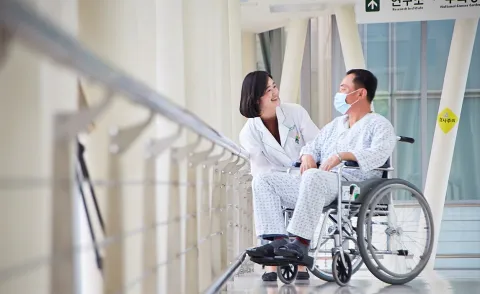Increasing cancer survival rates through a national cancer control plan: case study
The Republic of Korea is embarking on the 4th phase of the implementation of its national cancer control plan (NCCP), work that is being carried out by the National Cancer Center Korea and documented by UICC.

The National Cancer Center Korea (NCCK) became a Benefactor Partner of UICC in 2019. Given the successful implementation of the NCCP in Korea as well as the impressive national-level data NCCK uses to monitor the progress and inform further policy actions, UICC and NCCK have worked together to produce a case study capturing the content, process, lessons learned and next steps on Korea’s NCCP to share best practices with the cancer community.
A cohesive and comprehensive national cancer control plan is the cornerstone of a successful response to cancer in a country. It enables government authorities to identify and prioritise their population’s needs – which types of cancer are most prevalent, who requires the services most urgently, where are the gaps in essential service provision – and then determine the resources required to address them and how to allocate them. An effective NCCP will provide pathways to implement the most impactful and resource-effective interventions to reduce the national cancer burden and improve cancer patient outcomes.
The Republic of Korea, where cancer is responsible for one out of every three deaths, marks this year the end of the third implementation phase of its national cancer control plan, which has contributed in the past 25 years to an increase in the 5-year survival rates from 43% in the 1990s to 70.4% in 2017. The country’s cancer control programme serves to illustrate how implementing a well-designed NCCP, which is adapted to a country’s specific context, requirements and resources, can lead to measurable improvements for cancer patients.
“National Cancer Control Plans are instrumental in guiding health planners effectively as they determine how to address gaps in cancer care in their country. The Republic of Korea’s NCCP perfectly illustrates the successive steps that can be taken to develop a cancer control programme that is tailored to the country’s needs and resources – and that delivers on its goals, for patients, caregivers and policymakers.”
– Dr Sonali Johnson, Head of Knowledge, Advocacy and Policy, UICC
A step-by-step process
The Republic of Korea’s national cancer control plan was initiated in 1996. This led to the adoption in 2000 of the National Cancer Center Act and a year later to the establishment of the National Cancer Center Korea (NCC Korea) as a control tower of the country’s NCCP, integrating regional cancer registries into a national cancer registration system. Next year therefore marks the 20th anniversary of the NCC Korea, the end of the 3rd phase of the national cancer control plan that started in 2016 (or 3rd NCCP) and the beginning of the 4th that extends till 2025.
Indeed, the Republic of Korea’s national cancer control plan outlined several stages of implementation: a first 10-year plan till 2005, including the creation of the NCC Korea as well as the establishment of the Research Institute in the National Cancer Center in 2005; a second 10-year plan from 2006-2016, including the establishment of the Center for Cancer Prevention and Detection; then subsequent five-year national control plans (2016-2020, 2021-2025).
The third NCCP was conceived by NCC Korea with four main goals: reduce the incidence rate of cancer to the average rate seen in OECD countries (301.1 per 100,000); increase early detection and survival; improve the quality of life for cancer patients and survivors; and continue to lay the foundation for customised medical treatment. It has pushed the supportive programs for cancer survivorship, Korea came to be able to cover almost all areas of cancer control from cancer prevention to palliative care service.
"The smoking rate of Korea has been decreased from 35.2 in 1998 to 21.1 in 2018[1], owing to comprehensive tobacco control policies since 1998. In addition, as the 3rd NCCP has pushed the supportive programmes for Cancer Survivorship, Korea came to be able to cover almost all areas of cancer control from cancer prevention to palliative care service."
– Dr Eun Sook Lee, President of NCCK
From design to implementation and evaluation
To achieve its goals, the NCCP identified six focus or key intervention areas. The first, surveillance and protection sought to expand on an already solid cancer registration system that was set up to identify cancer types and profiles and tailor regulations accordingly. The second, early detection, involved further expanding the National Cancer Screening Programme, created in 2002 to include lung cancer along with gastric, liver, colorectal, breast and cervical cancer. The programme has been successful in reducing the number of patients whose cancer is detected at a late stage when the disease is harder to treat, the treatment more onerous for the patient, the outcomes are more serious and survival more uncertain.
The third key intervention involved diagnosis, treatment and survivorship. It built on the cost-cutting measures for low-income cancer patients and the new diagnostic and treatment tools introduced during the 1st and 2nd NCCPs to address the lack of comprehensive support for cancer patients and survivors, including children. This involved a system for managing the side effects of treatment and survival, developing rehabilitation and relapse prevention, and promoting physical and psychosocial health.
Palliative care constituted a fourth focus area that increased the number of specialised institutions and diversified the delivery of palliative care. The fifth key intervention, infrastructure, involved creating a national cancer data centre to support the Republic of Korea’s existing regional cancer centres. Finally, the 3rd NCCP focused on research and development, increasing expenditure by 13.7% annually and registering 2,400 patents in cancer research.
The evaluation process of the 3rd phase highlighted the Republic of Korea’s remarkable implementation and regular monitoring, using national-level data to measure progress and policy action. Not only have cancer survival rates increased, but the programme has extended the scope and reach of the country’s cancer control in terms of population, cancer types, and the cancer journey (from prevention and early diagnosis, to research, patient experience, palliative care and survivorship).
One area that was identified as meriting greater focus and strengthening is research and development, with the need for long-term strategies for cancer research, coordinate research projects nationally and expand the scope of research and development internationally.
While the first through the third stages of the NCCP were focused on devising cancer control programmes and pursuing quantitative growth, the fourth stage (2021-2025) aims to distribute the benefits of NCCP to people of every class.
In 2020 particularly, the Cancer Control Act was revised to provide a legal basis for the establishment of the national cancer big data (K-Cancer DW). Using cancer big data, we can now tailor cancer control programmes for all populations. This is expected to contribute to reducing the gap in accessing the benefits in terms of cancer control policy.
The impact of ageing and lifestyle on cancer incidence
A key lesson of the NCCP has been that while survival rates have increased, the incidence rates for all cancers have continued to rise. However, the effective data registry shows this is essentially due to lifestyle changes and most importantly to the fact that the population is ageing rapidly. As UICC has highlighted, older adults are a higher risk category for getting cancer – and also require more specific cancer care.
As the fourth stage of the NCCP will concentrate on designing a customised cancer control policy for all social groups by using cancer big data, it will certainly include programmes for ageing cancer patients.
____________________________
1 Ministry of Health and Welfare, Korea Disease Control and Prevention Agency(Sep 8, 2020), “Korea National Health & Nutrition Examination Survey Fact Sheet (1998-2018)”
Last update
Monday 09 November 2020
